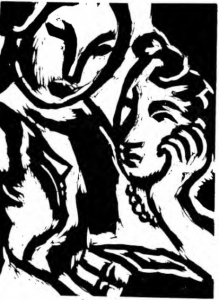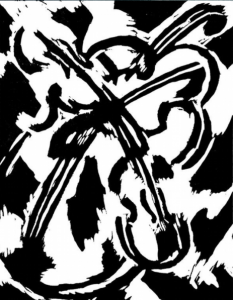Moments of Being: Virginia Woolf's Short Fiction
/ I bought my first collection of Virginia Woolf’s short fiction in Brighton as an undergraduate on a study trip to “Bloomsbury in Sussex” (Charleston, Monks House, the river Ouse). Its cover, a detail from the painting Synthesis of the Supper Room at an Arts Club Reception by the Scottish post-impressionist Stanley Cursiter, patchworks together people and coffee cups, giving a sense of immediacy, of the fleeting moment, of lived experience. This depiction of the experience of consciousness, as Woolf put it in her essay “Modern Fiction,” the intention to “record the atoms as they fall upon the mind,” is also what draws me back to her short fiction.This particular edition is noteworthy for reasons beyond its excellent cover. The text follows the original order of the anthology of short stories Monday or Tuesday published by the Woolfs at the Hogarth Press in 1921. Further stories are represented in date order. This edition also shows the original woodcut illustrations designed by Woolf’s sister, the modernist artist Vanessa Bell, for Monday or Tuesday.
I bought my first collection of Virginia Woolf’s short fiction in Brighton as an undergraduate on a study trip to “Bloomsbury in Sussex” (Charleston, Monks House, the river Ouse). Its cover, a detail from the painting Synthesis of the Supper Room at an Arts Club Reception by the Scottish post-impressionist Stanley Cursiter, patchworks together people and coffee cups, giving a sense of immediacy, of the fleeting moment, of lived experience. This depiction of the experience of consciousness, as Woolf put it in her essay “Modern Fiction,” the intention to “record the atoms as they fall upon the mind,” is also what draws me back to her short fiction.This particular edition is noteworthy for reasons beyond its excellent cover. The text follows the original order of the anthology of short stories Monday or Tuesday published by the Woolfs at the Hogarth Press in 1921. Further stories are represented in date order. This edition also shows the original woodcut illustrations designed by Woolf’s sister, the modernist artist Vanessa Bell, for Monday or Tuesday. Just as short fiction was an important medium for Woolf, woodcuts were an important part of Bell’s oeuvre. She published a number in a collection of Original Woodcuts by Various Artists by the Omega Workshops, of which Bell was a founder, in 1919. These included Dahlias and Nude which was also a variation on her painting The Tub. Similarly, the woodcut accompanying Woolf’s short story “A Society” echoes her painting A Conversation. These two works by Bell, like Woolf’s story, are concerned with female societies, the relationships between women that Woolf argued had gone unrecorded in fiction. “A Society” ends its satire of male intellectual superiority with the conclusion that “once she [a daughter] knows how to read there’s only one thing you can teach her to believe in – and that is herself”. This self-belief is something that Woolf’s fiction itself provides. In particular, these short stories open up the minds of female characters for brief but intense spells, giving women a place in literature as thinkers and autonomous beings.Woolf wrote that her short stories were both “wild outbursts” and “treats I allowed myself when I have done my exercise in the conventional style,” showing how important they were as a space in which to experiment and express raw thought and feeling. The pair of very short stories “Blue and Green” are such works. They sit beside each other on a pair of pages about half way through the Penguin Classics volume and are a complete shift in tone towards prose poetry. “Green” begins as the colour of glass shards, perhaps recognisable as a lampshade on a fireplace which throws green light onto the marble top. That is, until the imagination takes hold of the colour and rushes with it through rainforest, desert and ocean until green transforms, with the onset of night, into blue. “Blue” then follows:
Just as short fiction was an important medium for Woolf, woodcuts were an important part of Bell’s oeuvre. She published a number in a collection of Original Woodcuts by Various Artists by the Omega Workshops, of which Bell was a founder, in 1919. These included Dahlias and Nude which was also a variation on her painting The Tub. Similarly, the woodcut accompanying Woolf’s short story “A Society” echoes her painting A Conversation. These two works by Bell, like Woolf’s story, are concerned with female societies, the relationships between women that Woolf argued had gone unrecorded in fiction. “A Society” ends its satire of male intellectual superiority with the conclusion that “once she [a daughter] knows how to read there’s only one thing you can teach her to believe in – and that is herself”. This self-belief is something that Woolf’s fiction itself provides. In particular, these short stories open up the minds of female characters for brief but intense spells, giving women a place in literature as thinkers and autonomous beings.Woolf wrote that her short stories were both “wild outbursts” and “treats I allowed myself when I have done my exercise in the conventional style,” showing how important they were as a space in which to experiment and express raw thought and feeling. The pair of very short stories “Blue and Green” are such works. They sit beside each other on a pair of pages about half way through the Penguin Classics volume and are a complete shift in tone towards prose poetry. “Green” begins as the colour of glass shards, perhaps recognisable as a lampshade on a fireplace which throws green light onto the marble top. That is, until the imagination takes hold of the colour and rushes with it through rainforest, desert and ocean until green transforms, with the onset of night, into blue. “Blue” then follows:
The snub-nosed monster rises to the surface and spouts through his blunt nostrils two columns of water, which, fiery-white in the centre, spray off into a fringe of blue beads… Thrown upon the beach he lies, blunt, shedding dry blue scales. Their metallic blue stains the rusty iron on the beach. Blue are the ribs of the wrecked rowing boat. A wave rolls beneath the blue bells. But the cathedral’s different, cold, incense laden, faint blue with the veils of madonnas.
The images crash and roll into one another building meaning and association so that by the time we reach the cathedral it also feels like the vast belly of a whale deep beneath the ocean. The stories follow the mind, moving unexpectedly between ideas and images, an important experiment in “record[ing] the atoms as they fall upon the mind.” This concept is extended in a story like “In the Orchard” where Woolf sets the interior meanderings of her heroine Miranda, dozing under the apple trees, amongst the activities of the human and natural world around her. The interconnectivity of these spheres is emphasised throughout. The noise of a scolded classroom, for example,
This concept is extended in a story like “In the Orchard” where Woolf sets the interior meanderings of her heroine Miranda, dozing under the apple trees, amongst the activities of the human and natural world around her. The interconnectivity of these spheres is emphasised throughout. The noise of a scolded classroom, for example,
passed four feet above Miranda’s head, went through the apply boughs, and striking the cow-man’s little boy who was picking blackberries in the hedge when he should have been at school, made him tear his thumb on the thorns.
The scene is painted by Woolf three times. The second version deeper explores Miranda’s thoughts: we realise that at this same moment Miranda is imagining herself atop of a sea cliff, then as a seagull, then floating on the surface of the ocean. The final section pans back out to look at the natural world which frames Miranda’s thoughts, the mounds of fruit and leaves and the deep roots of the apple trees. This story, which takes less than three pages to be told, goes deep into a moment, examines it from various angles, and expresses the relationships between human subjectivity and the natural world. This relates to Woolf’s concept of life that “behind the cotton wool” or the effluvia of everyday existence “is hidden a pattern; that we – I mean all human beings – are connected with this; that the whole world is a work of art.” As Sandra Kemp has written, Woolf’s short fiction has “more ‘rhythm’ than ‘narrative,’” more patterns than straight lines. For instance, a story like “The String Quartet” begins with the hurried and anxious interior monologue that accompanies socialising with a large room of people:
As Sandra Kemp has written, Woolf’s short fiction has “more ‘rhythm’ than ‘narrative,’” more patterns than straight lines. For instance, a story like “The String Quartet” begins with the hurried and anxious interior monologue that accompanies socialising with a large room of people:
the mind’s shot through by such little arrows, and – for human society compels it – no sooner is one launched than another presses forward… if saying one thing does, in so many cases, leave behind it a need to improve and revise, stirring besides regrets, pleasures, vanities, desires.
Once the string quartet begins to play there is a change in mood, a rush of imagery and an elaborate story seemingly inspired by the music. The vivacity of the violins is also emphasised in Bell’s accompanying woodcut, which appears both as one animated violin and all four merged together. A contemporary reviewer in the Times Literary Supplement wrote that “prose ‘may aspire to the condition of music’; it cannot reach it,” but here I would argue the very opposite. Woolf’s work shows the mind’s ability to be moved, whether that is by the music created by a string quartet, the noise from a school classroom, or a woodcut in a book of short fiction.The mind alone in rapture is one narrative that repeats itself in these short stories, but there is also the struggle to know others. The last story in the book “Lappin and Lapinova” is told by the newly-wed Rosalind who, tentative of the marriage, creates an elaborate fantasy world in which she and her new husband Ernest are actually “King and Queen of the land of rabbits and hares”. The fantasy sustains the couple, who share this secret world of misty gorse, swamps and woodland until Ernest tires of the façade and retreats back into the real world. She struggles to reclaim their fairy tale realm but Ernest manages to completely destroy it:
‘It’s Lapinova…’ she faltered, glancing wildly at him out of her great startled eyes. ‘She’s gone, Ernest. I’ve lost her!’Ernest frowned. He pressed his lips tight together. ‘Oh, that’s what’s up, is it?’ he said, smiling rather grimly at his wife […]‘Yes,’ he said at length. ‘Poor Lappinova…’ He straightened his tie at the looking-glass.‘Caught in a trap,’ he said. ‘Killed,’ and sat down and read the newspaper.
The story relates the fragility of the fictions we create about ourselves and our relationships, the need to create methods for translating our being with others. Moreover, the story is both a love story between humans and a love story about story telling itself. The fiction of Lappin and Lapinova sustains Rosalind. Indeed, it is the reason for their falling in love in the first place, emphasizing the powerful and seductive qualities of fiction.Woolf’s short fiction is under-appreciated in comparison with her novels, but the style and rhythm of larger experimental works like The Waves come out of these short outpourings of place and feeling. Woolf’s short fiction allows you to dip into an intense moment of being. You are briefly submerged before coming up for air, given a moment to look around at your own world before plunging back in.
Zoe Wolstenholme has worked with the art and literary collections at The Charleston Trust and Royal Botanic Gardens, Kew, writing for the Charleston Attic and Kew’s Library Art and Archives Blog. She currently blogs for Blogging Woolf and her academic work can be read in Intellect’s Clothing Cultures.






